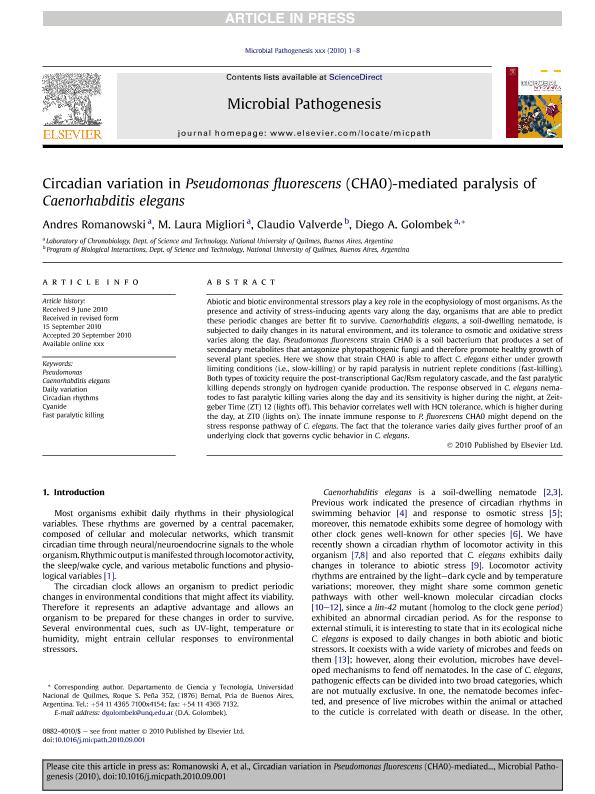Mostrar el registro sencillo del ítem
dc.contributor.author
Romanowski, Andrés

dc.contributor.author
Migliori, María Laura

dc.contributor.author
Valverde, Claudio Fabián

dc.contributor.author
Golombek, Diego Andrés

dc.date.available
2018-07-31T19:02:01Z
dc.date.issued
2011-01
dc.identifier.citation
Romanowski, Andrés; Migliori, María Laura; Valverde, Claudio Fabián; Golombek, Diego Andrés; Circadian variation in Pseudomonas fluorescens (CHA0)-mediated paralysis of Caenorhabditis elegans; Academic Press Ltd - Elsevier Science Ltd; Microbial Pathogenesis; 50; 1; 1-2011; 23-30
dc.identifier.issn
0882-4010
dc.identifier.uri
http://hdl.handle.net/11336/53647
dc.description.abstract
Abiotic and biotic environmental stressors play a key role in the ecophysiology of most organisms. As the presence and activity of stress-inducing agents vary along the day, organisms that are able to predict these periodic changes are better fit to survive. Caenorhabditis elegans, a soil-dwelling nematode, is subjected to daily changes in its natural environment, and its tolerance to osmotic and oxidative stress varies along the day. Pseudomonas fluorescens strain CHA0 is a soil bacterium that produces a set of secondary metabolites that antagonize phytopathogenic fungi and therefore promote healthy growth of several plant species. Here we show that strain CHA0 is able to affect C. elegans either under growth limiting conditions (i.e., slow-killing) or by rapid paralysis in nutrient replete conditions (fast-killing). Both types of toxicity require the post-transcriptional Gac/Rsm regulatory cascade, and the fast paralytic killing depends strongly on hydrogen cyanide production. The response observed in C. elegans nematodes to fast paralytic killing varies along the day and its sensitivity is higher during the night, at Zeitgeber Time (ZT) 12 (lights off). This behavior correlates well with HCN tolerance, which is higher during the day, at ZT0 (lights on). The innate immune response to P. fluorescens CHA0 might depend on the stress response pathway of C. elegans. The fact that the tolerance varies daily gives further proof of an underlying clock that governs cyclic behavior in C. elegans. © 2010 Elsevier Ltd.
dc.format
application/pdf
dc.language.iso
eng
dc.publisher
Academic Press Ltd - Elsevier Science Ltd

dc.rights
info:eu-repo/semantics/openAccess
dc.rights.uri
https://creativecommons.org/licenses/by-nc-sa/2.5/ar/
dc.subject
Caenorhabditis Elegans
dc.subject
Circadian Rhythms
dc.subject
Cyanide
dc.subject
Daily Variation
dc.subject
Fast Paralytic Killing
dc.subject
Pseudomonas
dc.subject.classification
Otras Ciencias Biológicas

dc.subject.classification
Ciencias Biológicas

dc.subject.classification
CIENCIAS NATURALES Y EXACTAS

dc.title
Circadian variation in Pseudomonas fluorescens (CHA0)-mediated paralysis of Caenorhabditis elegans
dc.type
info:eu-repo/semantics/article
dc.type
info:ar-repo/semantics/artículo
dc.type
info:eu-repo/semantics/publishedVersion
dc.date.updated
2018-07-30T18:00:48Z
dc.journal.volume
50
dc.journal.number
1
dc.journal.pagination
23-30
dc.journal.pais
Países Bajos

dc.journal.ciudad
Amsterdam
dc.description.fil
Fil: Romanowski, Andrés. Universidad Nacional de Quilmes. Departamento de Ciencia y Tecnología. Laboratorio de Cronobiología; Argentina. Consejo Nacional de Investigaciones Científicas y Técnicas; Argentina
dc.description.fil
Fil: Migliori, María Laura. Universidad Nacional de Quilmes. Departamento de Ciencia y Tecnología. Laboratorio de Cronobiología; Argentina
dc.description.fil
Fil: Valverde, Claudio Fabián. Universidad Nacional de Quilmes. Departamento de Ciencia y Tecnología. Laboratorio de Cronobiología; Argentina. Universidad Nacional de Quilmes. Departamento de Ciencia y Tecnología; Argentina
dc.description.fil
Fil: Golombek, Diego Andrés. Universidad Nacional de Quilmes. Departamento de Ciencia y Tecnología. Laboratorio de Cronobiología; Argentina. Universidad Nacional de Quilmes. Departamento de Ciencia y Tecnología. Laboratorio de Cronobiología; Argentina
dc.journal.title
Microbial Pathogenesis

dc.relation.alternativeid
info:eu-repo/semantics/altIdentifier/doi/https://dx.doi.org/10.1016/j.micpath.2010.09.001
dc.relation.alternativeid
info:eu-repo/semantics/altIdentifier/url/https://www.sciencedirect.com/science/article/pii/S0882401010001774
Archivos asociados
